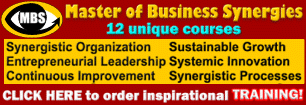|
Strategic Management New Approaches for the New Era of Rapid and Systemic Change |
|
by Vadim Kotelnikov & Ten3 East-West
"Our real problem is not our strength today; it is rather the vital necessity of action today to ensure our strength tomorrow."
- Calvin Coolidge

|
Differences between Strategic Management and Classic Managerial Functions
|
Strategic Management:
|
Why Strategic Management? Strategic management is not a task, but a rather a set of managerial skills that should be used throughout the organization, in a wide variety of functions. Strategic cross-functional management is central to capitalizing on functional excellence, and in order for functional specialists to make the greatest possible contribution, they must take a broader view of their functions and understand how they fit into the web of the organizational processes and, ultimately, into the overall strategy. Ten Major Schools of Strategic Management Ten deeply embedded, though quite narrow, concepts typically dominate current thinking on strategy. These range from the early Design and Planning schools to the more recent Learning, Cultural and Environmental Schools4...More New Systemic Approach to Strategic Management All the above schools, often fighting between themselves, favor different single-sided approaches to strategy formulation. They represent both different approaches to strategy formulation and different parts of the same process. Today's managers have to deal with the entire business system - as opposite to dealing with its different parts independently - not only to keep strategy formulation as as a vital force but also to impart real energy to the strategic process. They have to practice balanced results-based leadership strategies as well as apply a balanced approaches to business systems. Certain positive moves in this direction have been seen recently. Some of the more recent approaches to strategy formulation take a wider perspective and cut across the above ten schools in eclectic and interesting ways, for example Learning and Design in the "Dynamic Capabilities" approach, or the "Dynamic Strategy" one based on knowledge working. The currently dominant view of business strategy - resource-based theory - is based on the concept of economic rent and the view of the company as a collection of capabilities. This view of strategy has a coherence and integrative role that places it well ahead of other mechanisms of strategic decision making.5 Working On Your Business "Most businesspeople are so busy working for their business or in their business that they never find time to work on their business. Thus they fail to anticipate what might happen or what they might be able to make happen."7 Unless you regularly schedule time (one-day out-of-the-office meeting a month at least) to work on your business and answer critical questions, you'll never achieve your stretch goals...More Strategic Innovation: Road-Mapping The goal of the road-mapping is to develop the innovation strategy - to choose and do the right things. The goal of innovation management is to implement this strategy well...More
|
|||||||||||||||||
Bibliography:
-
"Strategic Management", Alex Miller, 1998
-
"Strategic Management - Competitiveness and Globalization", M.A. Hint, R.D. Ireland, and R.E. Hoskisson, 2001
-
"Strategic Enterprise Management Systems", Martin Fahy, 2002
-
"Strategy Safari: A Guided Tour Trough the Wilds of Strategic Management", Henry Mintzberg, Bruce Ahlstrand, and Joseph Lampel, 1998
-
"Strategy and the Delusion of Grand Designs", John Kay, 2003
-
"Changing Strategic Direction", Peter Skat-Rordam, 2003
-
"It's not the BIG and eats the SMALL... it's the FAST that eats the SLOW", Jason Jennings and Laurence Haughton, 2000

